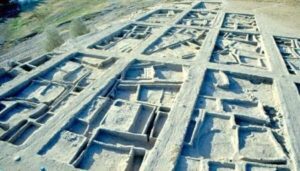
If you travel south along the road near the small, southern Turkish village of Kizilkaya, you will encounter a two-story red building, the old office for the headman of the village. A dark shop under the building belongs to an old carpenter. You can hear him as he works – the sounds of saw and hammer – as you follow the stone-paved road lined with trees on both sides. After a few hundred meters, you will see a mound about fourteen to fifteen meters high, covered by grass.
The villagers call it Aşıklı Höyük. It is not a natural mound. It actually began its formation about ten millennia ago, when people settled and built dwellings, staying for a thousand years and then vanished, leaving remains, like a layer cake of towns atop other towns, only vestiges of which ultimately survived the ravage of time.
Today, however, it is a quiet place – no one lives there anymore – but nearby you will sometimes see and hear children and teenagers playing in and around the water of the adjacent Melendiz River. They remove their clothes down to their underwear and catch the scaly fish known as gray mullet with sack-like nets they hold in their hands. If it is the weekend, you may see and smell the mix of smoke and meat. Those who arrive from Aksaray and the surrounding villages and districts parcel out the shade for picnics. In the fields on both sides of the river, the villagers are deeply occupied with hoeing, irrigation or harvesting, according to the season. And if you had a time machine and you were able to arrive here a century or even a few millennia ago, you would encounter almost the same scene: children fishing and playing in the river; barley and wheat fields scattered here and there; and villagers working in these fields… It would be as if nothing had changed for centuries, even millennia.
But go back more than nine thousand years at the place where this mound now stands and you would likely encounter a very different scene. You would see about a dozen houses in two groups. They are flat-roofed, single-story houses constructed of adobe – a construction material the local people today would not prefer much when building their own houses. The walls of these ancient houses are either shared between separate units, or the spaces between the houses are so narrow that not a single person could negotiate between them. These spaces are filled with bones, stones, and other materials, much like a dump. Areas that people use for various purposes, such as meeting houses, streets for travel, gardens, courtyards or squares are almost nonexistent among the houses.
And there is another curious feature, or lack thereof: These houses have no doors for entry. To enter a house, you must ascend an exterior ladder and go inside through an opening in the roof, then descend an interior ladder. The only source of light is the opening in the roof you used to enter, and one or two holes in a wall, a hole far too small to be called a window by modern standards. Once your eyes adjust to the dim environment, you can move about. You can see that it is not a very large space. The ancients who lived here built their houses with one or two rooms and only rarely with three rooms. Generally, there is a main room, which measures ten to twelve square meters, and a smaller adjoining back room. Some houses contain an earthen bench (a raised place) raised from the ground for five to ten centimeters, used for sitting or lying in one corner of the room. This would be covered with an animal skin or a mat woven with reeds and various weeds. In another corner is a rectangular hearth about a meter in length and forty to forty-five centimeters in length, used for both cooking and heating. These hearths are standard to almost every house. They were built by placing palm-sized flat stones side by side upon the ground and then enclosing them with upright stones in order to prevent ashes, embers and other materials from spreading about.
You will notice bunches of various herbs and flowers hanging down the walls of the room and the central wooden post supporting the roof. They are herbs with names such as havacıva otu (alkanet/Alkanna), pisipisi otu (wild barley/Hordeum), sabun otu (soapwort/Saponaria), kedi otu (valerian/Valerianella coronata), kuzu kulağı (sheep’s sorrel/Rumex), sığır kuyruğu (mullein/Verbascum), gıcıgıcı (silene/Silene), and çoban yastığı (prickly thrift/Thymelaea), used as food or for medicinal treatment. Some of them are still used today by villagers. Based on excavations and research, archaeologists have determined that the ancient people of Aşıklı Höyük subsisted substantially on such wild plants and harvested plants as barley, wheat, and lentil. Almonds, hackberry, chickpeas and legumes were abundantly consumed. Moreover, given the very large amount of bones recovered during excavations, it is clear they were very good hunters, with meat playing an important role in their diet, including wild cattle, wild sheep and goats, warthogs, deer and roe deer. At the beginning of their settlement, sheep and goat had not yet been domesticated, although their wild species were controlled in herds consisting of small numbers, kept within the settlement, and in time domesticated during the thousand-year occupation of the site. Apart from these animals, various bird species, fish and small animals like rabbits would likely have been found on the table of an ordinary family living in Aşıklı.
____________________________________________
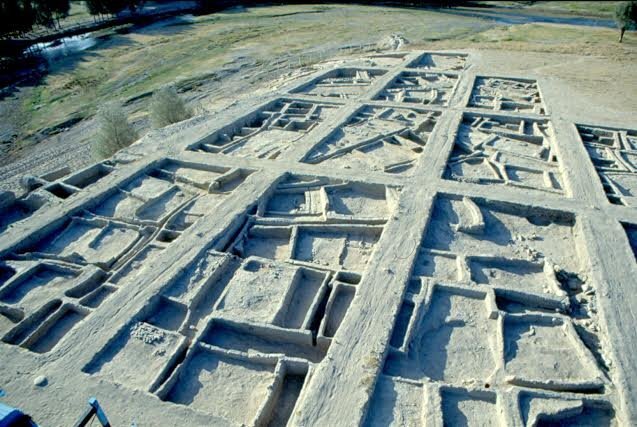 The architectural remains of the 8th millennium BC settlement of Aşıklı Höyük. From the Aşıklı Höyük archive.
The architectural remains of the 8th millennium BC settlement of Aşıklı Höyük. From the Aşıklı Höyük archive.
____________________________________________________________
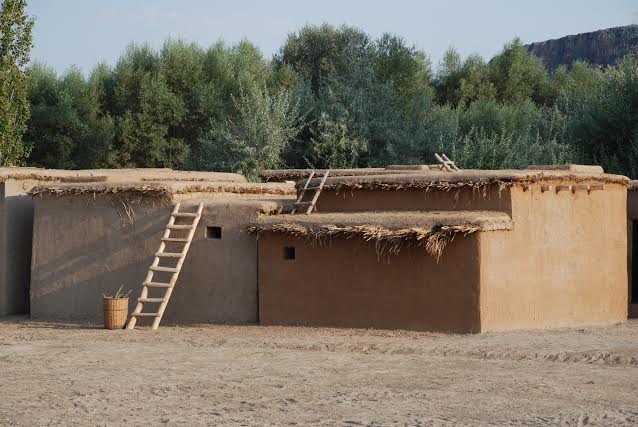 Modern experimental reconstruction of the ancient houses, built next to the mound. From the Aşıklı Höyük archive.
Modern experimental reconstruction of the ancient houses, built next to the mound. From the Aşıklı Höyük archive.
____________________________________
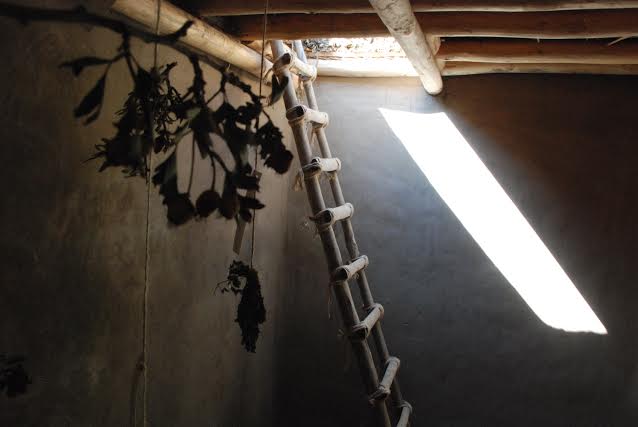 A view inside of one of the modern experimentally reconstructed houses. From the Aşıklı Höyük archive.
A view inside of one of the modern experimentally reconstructed houses. From the Aşıklı Höyük archive.
______________________________________
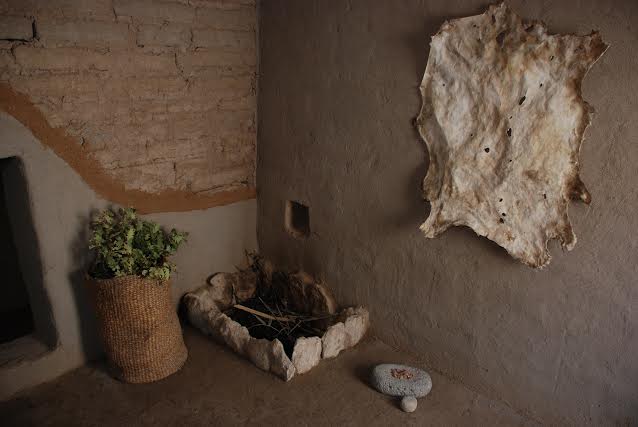 Above and below: Reconstructions show interior appearance of the ancient houses. Note the reconstructed hearth in each photo. From the Aşıklı Höyük archive
Above and below: Reconstructions show interior appearance of the ancient houses. Note the reconstructed hearth in each photo. From the Aşıklı Höyük archive
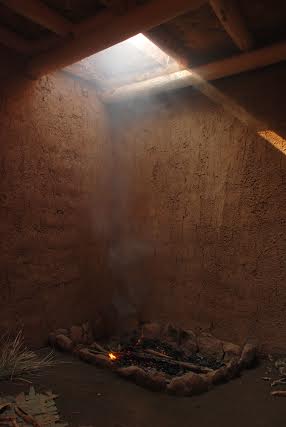 __________________________________________________________
__________________________________________________________
An Obsidian Trade?
If your eyes have become accustomed to the darkness rather well and you look at the floor of the house carefully, you may also encounter a pile of black glassy stones at one corner. These stones are a type of volcanic stone called obsidian or natural glass, the local name of which is “deve cıncığı”. Today we primarily use minerals to make such tools as knives, spoons, and weapons. Likewise, the inhabitants of Aşıklı, some ten millennia ago, also used this obsidian to make the arrowheads and spearheads they used in hunting; knives they used to slaughter, skin, and process animals or to cut their own beards; and sickles with which they cut grass. The Cappadocia Region, which includes Aşıklı, is rich in obsidian. Because its properties allowed it to be easily processed into sharp edges and points, the ancients could shape it into useful tools and weapons. Its comparative rarity on the earth’s surface, its usefulness, and its attractive, polished appearance made it a valuable commodity for export to very distant regions such as Syria, the region called Israel-Palestine, and the island of Cyprus, even during the heyday of Aşıklı, a time when no means of transport beyond the human foot was yet available: The wheel had not yet been invented, and horses, donkeys and mules had not been domesticated.
Did the people of Aşıklı export and trade in obsidian?
That question remains unanswered, but archaeologists have uncovered seashells from the Mediterranean Sea among the remains at Aşıklı.
In addition to obsidian, there was basalt, granite and tuff – again, types of volcanic stones – which were are also among the stones frequently used by the people of Aşıklı to make various tools, such as grinding stones (mortars and pestles) used to grind plants and handstones and hammers used to separate nuts like almonds and pistachios from their shells. Animal bones and horns were also used for such tools as needles, awls, spoons and shovels, and even for adornment in the form of beads.
Household Burials
If you have the eye of an archaeologist, you may also spy what may have been a pit once dug into the floor, which was then covered with soil and pressed firmly. The people of Aşıklı commonly dug pits into their floors to bury their dead. Once refilled after burial, they would go on living above their deceased. This practice, which in many cultures today would be considered unthinkable, was a generally accepted tradition almost everywhere during the Neolithic Period. Skeletons of about eighty individuals buried in this way were unearthed in the excavations. Of course, not every individual who died in Aşıklı was buried beneath the floor of the house in this way. Where were the others buried? This question remains unanswered. In either case, all were buried at what in today’s terms would be considered a young age – examination of skeletal remains revealed that the average life-span of the people of Aşıklı was generally 30 to 35 years!
Visitors to the site of Aşıklı today would see modern replicas or reconstructions of these ancient structures, built based on the information gleaned from the excavations and research conducted by archaeologists and others who have painstakingly studied the remains, and constructed with the gracious help of the villagers of nearby Kizilkaya. During the summer months, archaeologists and their teams from all over the world are busy working at the site – arrive in the late morning and you may even be offered a glass of their tea.
A Temple?
The comparatively few visible remains at the site strike a vivid contrast to the monumental remains often seen at other ancient sites, particularly those of later time periods. The foundations of houses and some of the walls have hardly escaped the anger of time. Despite this, if you turn to Mount Hasan and walk downwards after you have reached the highest point of the mound, you will approach a section with special buildings. The settlement of Aşıklı consisted of two sections in antiquity. Separated by a four-meter-wide pebbly road, one section was the residential area, comprised of the houses just described. But the special section contained buildings with characteristics of a very different sort. One of these buildings, square in shape, measured twenty-five square meters. The floor, plastered with lime, along with its walls and benches, were painted entirely with red ochre. At four corners were large stones upon which were placed wooden posts. A small channel, opening to the outside, was built into one of the walls. Archaeologists investigating the structure suggest that it was probably used as a ceremonial place, with evidence suggesting that a kind of fluid was poured at these ceremonies. Associated with the building were other spaces, also likely used jointly by the residents of the settlement. Scholars have conjectured that it may have been a temple or sacred complex or public place, an assembly area where everyone gathered to make joint decisions or perhaps used for activities on special days or for social ceremonies. In any case, all the signs seemed to point to this place as something special, something other than a common dwelling place.
___________________________________________
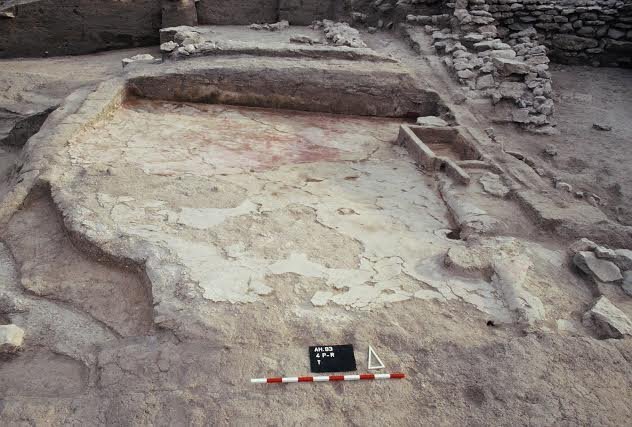 The special or communal building. The floor and walls of the building were painted red in antiquity, as can be seen evidenced in the remains. Different layers of the building can be seen on the bottom left corner of the photo. From the Aşıklı Höyük archive.
The special or communal building. The floor and walls of the building were painted red in antiquity, as can be seen evidenced in the remains. Different layers of the building can be seen on the bottom left corner of the photo. From the Aşıklı Höyük archive.
______________________________________
The evidence thus far suggests that the residents of Aşıklı Höyük abandoned this place, where they had lived for more or less a thousand years about nine millennia ago, then migrated somewhere else. Where and why they went are only two of a long list of questions. Some nine millennia have elapsed since, the building remains becoming the mound we see today. But, in a very real sense, this ancient settlement is coming alive again through the ongoing search for answers by a team under the leadership of Mihriban Özbaşaran of İstanbul University. The story of this early Neolithic town continues to unfold.
____________________________________________________________
Subscribe to Popular Archaeology Premium. Available on all laptops and mobile devices, and still the industry’s best value at only $9.00 annually.
___________________________________________
Travel and learn with Far Horizons.
____________________________________________
This richly illustrated issue includes the following stories: Recent findings shedding new light on the whereabouts of the remains of Philip of Macedon, father of Alexander the Great; how an archaeologist-sculptor is bringing bones of the dead back to life; archaeologists uncovering town life at the dawn of civilization; an exclusive interview with internationally acclaimed archaeologist James M. Adovasio about what makes the Meadowcroft Rockshelter prominent in the ongoing search for the first Americans; what archaeologists are finding at the site of the ancient city of Gath, the home town of the biblical Philistine giant, Goliath; and how scientists are redrawing the picture of human evolution in Europe. Find it on Amazon.com.






